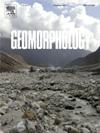Reconstructing the geological and geomorphological history of Morella Crater, Mars
IF 3.1
2区 地球科学
Q2 GEOGRAPHY, PHYSICAL
引用次数: 0
Abstract
Ancient impact craters on Mars provide insights into the geological events and are time markers for studying global processes like colossal volcanism and fluvial activities. Among these craters, the 77 km diameter Morella Crater serves as a representative, capable of demonstrating diverse processes that acted on Martian terrain, and hence, the geological and geomorphological history of this crater is studied in detail. Despite its infilling, Morella hosts Ganges Cavus, a significant collapse structure, and Elaver Vallis, an outflow channel. We hypothesize the development of the crater through five stages, from its origin to its current denuded state, exhibiting diverse processes that determine the fate of Martian craters. Crater size-frequency distribution suggests a formation age of Ga for the plateau hosting Morella Crater and Ga for Morella Plains, the vast expansive plains within the crater. The occurrence of pyroxene and olivine in Morella Plains, identified through hyperspectral data, indicates impact-induced volcanism. The heat source associated with faulting and dike intrusion in the adjoining Ophir Catenae Structural Complex might have ruptured the confined cryosphere, resulting in the formation of Ganges Cavus and eventual filling of Morella with water, which subsequently breached to form Elaver Vallis at Ga. Hydraulic modelling reveals a floodwater volume of 3.27 × 1012 m3 and an estimated peak discharge of 3 × 107 m s−1 associated with this event. Morella witnessed additional fluvial activity at Ga that created the dark-toned channels. The extensive range of geological and geomorphological processes makes Morella Crater a promising location for future Mars missions.

求助全文
约1分钟内获得全文
求助全文
来源期刊

Geomorphology
地学-地球科学综合
CiteScore
8.00
自引率
10.30%
发文量
309
审稿时长
3.4 months
期刊介绍:
Our journal''s scope includes geomorphic themes of: tectonics and regional structure; glacial processes and landforms; fluvial sequences, Quaternary environmental change and dating; fluvial processes and landforms; mass movement, slopes and periglacial processes; hillslopes and soil erosion; weathering, karst and soils; aeolian processes and landforms, coastal dunes and arid environments; coastal and marine processes, estuaries and lakes; modelling, theoretical and quantitative geomorphology; DEM, GIS and remote sensing methods and applications; hazards, applied and planetary geomorphology; and volcanics.
 求助内容:
求助内容: 应助结果提醒方式:
应助结果提醒方式:


